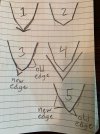- Joined
- Jun 8, 2019
- Messages
- 938
I posted a similar question on the maintenance forum, but got no replies.
I know I should learn to use a stone, but for now I have the Work sharp with only 2 angles (the WSKTS, not KO).
The book and the you tube videos all say to use the 25 dps for outdoor and pocket knives and the 20 dps for kitchen knives.
I understand the idea of the 25 being tougher and good for general outdoor stuff.
However both Buck and Case say to use an angle less than 20.
My carry rotation includes a Case stockman, Case mini copper lock, Boker stockman, Victorinox SAK camper.
My hunting knives are a Buck 110 and a smaller drop point Buck lock.
The hunting knives are mostly for gutting, skinning and quartering white tail deer.
The carry knives are for whatever comes up.... cutting rope, fishing, opening packages, etc.
I'd love to hear opinions on how you would sharpen these if your only options were either 20 or 25 degrees.
Also, do I need to 're grind them to the 20 or 25 if they are at like 16 or 17 from the factory?
Thanks and sorry for the long post.
I know I should learn to use a stone, but for now I have the Work sharp with only 2 angles (the WSKTS, not KO).
The book and the you tube videos all say to use the 25 dps for outdoor and pocket knives and the 20 dps for kitchen knives.
I understand the idea of the 25 being tougher and good for general outdoor stuff.
However both Buck and Case say to use an angle less than 20.
My carry rotation includes a Case stockman, Case mini copper lock, Boker stockman, Victorinox SAK camper.
My hunting knives are a Buck 110 and a smaller drop point Buck lock.
The hunting knives are mostly for gutting, skinning and quartering white tail deer.
The carry knives are for whatever comes up.... cutting rope, fishing, opening packages, etc.
I'd love to hear opinions on how you would sharpen these if your only options were either 20 or 25 degrees.
Also, do I need to 're grind them to the 20 or 25 if they are at like 16 or 17 from the factory?
Thanks and sorry for the long post.


